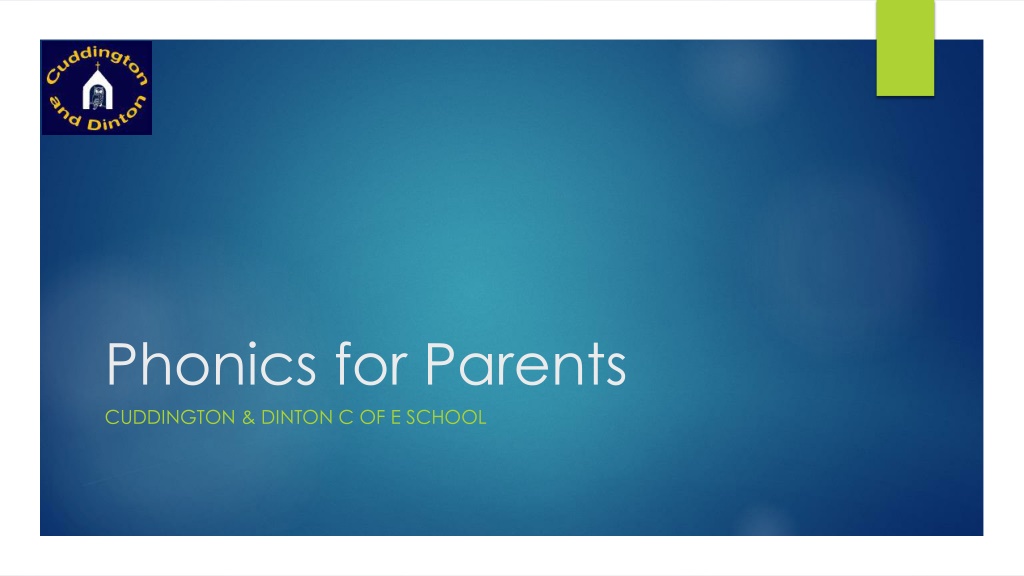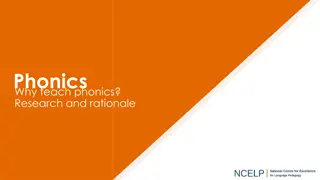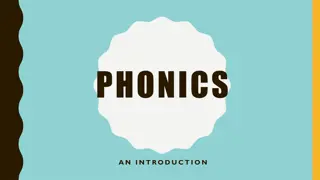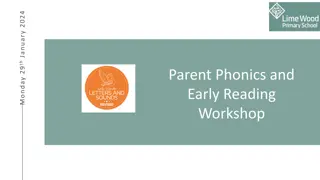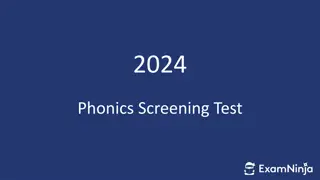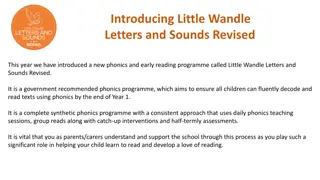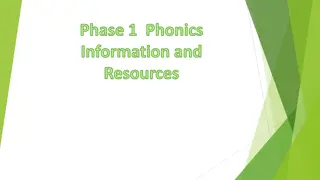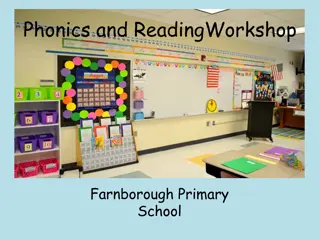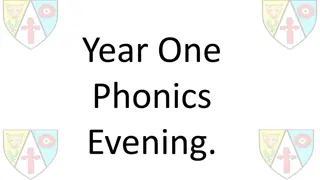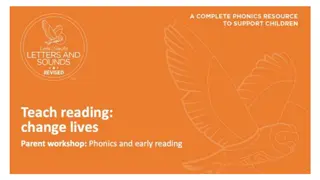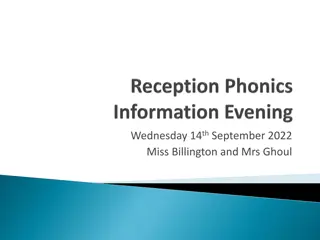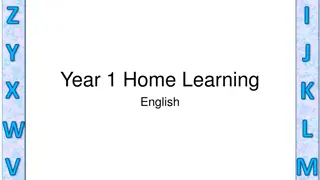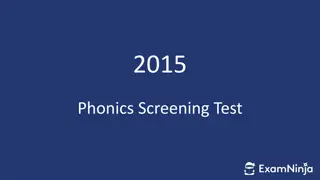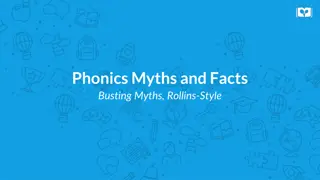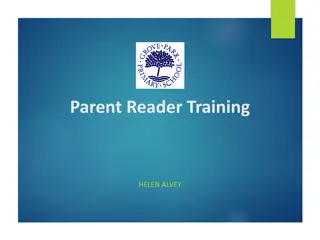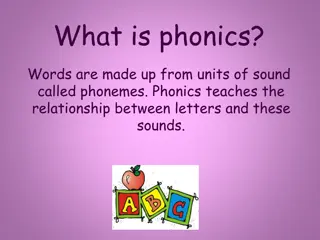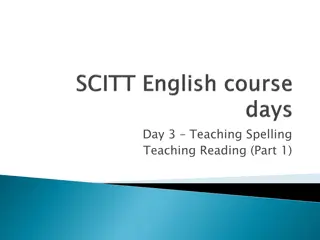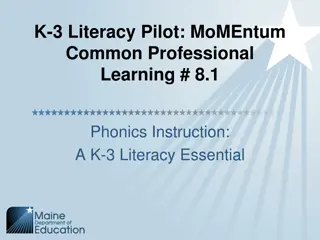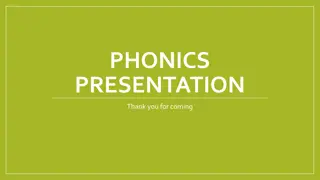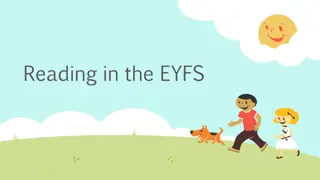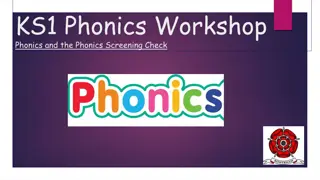Understanding Phonics: The Key to Reading Success
Phonics is the crucial link between letters and sounds, essential for children's reading skills. It involves learning the phonemes, graphemes, and letter combinations that make up words. A structured approach using programs like Jolly Phonics and Letters and Sounds helps children articulate sounds, blend them together, and eventually read with confidence. Explore the world of phonics and empower your child's literacy journey.
Download Presentation

Please find below an Image/Link to download the presentation.
The content on the website is provided AS IS for your information and personal use only. It may not be sold, licensed, or shared on other websites without obtaining consent from the author. Download presentation by click this link. If you encounter any issues during the download, it is possible that the publisher has removed the file from their server.
E N D
Presentation Transcript
Phonics for Parents CUDDINGTON & DINTON C OF E SCHOOL
Everything starts with reading! Being able to read is the most important skill children will learn during their time at school and their success at this skill has far reaching implications confidence and well-being. (Ref: Letters and Sounds) for life-long
Can you read this? It iz tiem too gow hoam sed v kator pilla. But iy doat wont 2 gow howm sed th butt or flie. Iy wot to staiy heyr.
What is phonics? Phonics is the link between letters and the sounds that they make Using a highly structured programme pupils are taught the letter code The key skill include to articulate all 44 phonemes To hear separate sounds To say and blend separate sounds
The phonics code 44 phonemes 26 letters 144 letter combinations It s complicated!
A two pronged approach Using Jolly Phonics to learn the phonemes/graphemes through song. VAK learning Combining Letters and Sounds scheme to blend from the start. Putting what they learn into action i.e. de-coding /blending and writing from the beginning. This in turn will lead to reading and guided reading.
What are speech sounds? Whilst the alphabet only has 26 letters there are more than 40 speech sounds (phonemes) https://www.google.co.uk/url?sa=t&rct=j&q=&esrc=s&source=web&cd=1 &cad=rja&uact=8&ved=0ahUKEwjPuoetvavQAhUBuhoKHdK8BMIQyCkIHD AA&url=https%3A%2F%2Fwww.youtube.com%2Fwatch%3Fv%3DBqhXUW_v -1s&usg=AFQjCNF8H1Ns46a8KlvawszypsekUeKBlA
Some helpful technical terms Phonemes the smallest unit of sound in a word Grapheme what we write to represent the sound / phoneme this could be more than one letter
Blending Oral Blending - This involves hearing phonemes and being able to merge them together to make a word. Children need to develop this skill before they will be able to blend written words. Blending- This involves looking at a written word, looking at each grapheme and using knowledge of GPCs to work out which phoneme each grapheme represents and then merging these phonemes together to make a word. This is the basis of reading.
Digraphs Two letters that make the same sound A consonant diagraph contains two consonants next to each other Sh, ch, th, nk, A vowel diagraph contains at least two vowel that only make one vowel sound (long vowels) ai, ee, ie, ou , ue
Trigraphs Sounds that are made up of 3 letters but make only one sound Igh, ing, ear, air
GPCs - Its complicated! Some words are more difficult to sound out and blend children need to have understanding of grapheme correspondences. the phoneme/
Non decodable words Some words can not be sounded out and these words need to be learnt by sight Children should be taught to read these words as whole words and not separate those words into phonemes Examples include said, the, These are taught as tricky words, we will be sending these home for you to learn The children will build their sight vocab through regular practise
High Frequency words why are they so important? It is really important that children learn how to read these words as they will make up a large proportion of the words they will be reading in everyday texts. They also need to learn to spell these words as they will find they will need to use them a great deal in their writing. (Research has shown that just 16 words, such as and , he , I and in , but also the more phonetically- difficult the , to , you , said , are , she and was , make up a quarter of the words in a piece of writing, whether it s for adults or children.)
High Frequency words why are they so important? The frequency of use) are: the, and, a, to, said, in, he, I, of, it, was, you, they, on, she, is, for, at, his, but, that, with, all, we, can, are, up, had, my, her, what, there, out, this, have, went, be, like, some, so, not, then, were, go, little, as, no, mum, one, them, do, me, down, dad, big, when, it's, see, looked, very, look, don't, come, will, into, back, from, children, him, Mr, get, just, now, came, oh, about, got, their, people, your, put, could, house, old, too, by, day, made, time, I'm, if, help, Mrs, called, here, off, asked, saw, make, an. top 100 high frequency words (in order of
